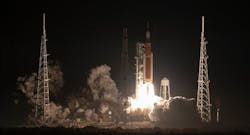The moon beckons once again, and this time NASA wants to stay
WASHINGTON - In 2010, during a speech at the Kennedy Space Center in Florida, President Barack Obama directed NASA away from its primary target, the moon, to focus its human exploration missions beyond the lunar surface to an asteroid and Mars, Christian Davenport writes for the Washington Post. Continue reading original article.
The Military & Aerospace Electronics take:
10 January 2023 - Davenport notes in his engaging, interactive piece for the Post that America has been to the moon before. So why the urge to go back?
In the proceeding 50-plus years since mankind's "giant leap" to and on the lunar surface, technology grown leaps and bounds itself. Now, it is known the moon holds some water. Not only does water keep life on Earth marching through time, Davenport writes that the hydrogen and oxygen building blocks of water also propel rockets. With one-sixth the gravity of Earth, the lunar surface may prove to be a springboard to getting people further afeild in our solar system.
“It’s important to recognize that we’re going back to a moon that’s really different than the moon we left when we took off during Apollo,” Thomas Zurbuchen, the recently retired head of NASA’s science mission directorate, said in an interview. “It was a moon that was dry. … Our understanding of the moon is massively different.”
“It’s less about finding life itself, but it certainly is about the journey to life,” Zurbuchen said. “The moon can tell us a lot about our own solar system, the violent processes that created our planets and scarred their surfaces. … Part of our history is right there, hanging out over our heads, and it is eminently possible to travel there.”
Related: NASA’s Artemis I 'mega rocket' launches tech-filled Orion spacecraft to the Moon
Related: NASA awards Artemis contract for future 'mega Moon' rocket boosters
Jamie Whitney, Associate Editor
Military + Aerospace Electronics
